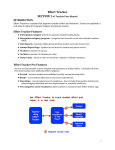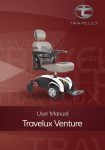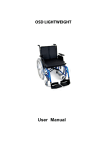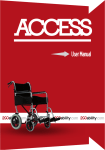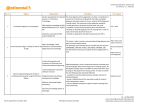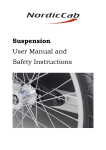Download Voorblad Xeryus Compact
Transcript
0208 Technical Manual Excel G5 Read instructions before use Technical user manual YOU AND / OR YOUR ATTENDANT MUST READ AND FULLY UNDERSTAND THIS MANUAL BEFORE USE General information You have just purchased a Van Os Medical UK Ltd wheelchair and we want to thank you for the confidence in our EXCEL® products. The EXCEL® wheelchair is a quality product. It is adjustable in many different ways and it can also be easily upgraded. The policy of Van Os Medical UK Ltd is to continually improve the quality and reliability of our products. We reserve the right, therefore, without prior notification, to alter this guide. Your new wheelchair requires frequent maintenance. Therefore we want you to take your wheelchair once a year to be inspected by a professional. You will find a maintenance schedule later on in this manual. You'll also find that this manual includes a detailed description of all the available settings of your wheelchair. We have tried to made the instructions easy to follow however if you have any questions please contact our technical department. Caution! In this guide you will find informative comments, recommendations and warnings. These are clearly identified by the below symbols and the appearance of the text: Tip Informative information Recommendation Damage to equipment is possible if recommendations are not followed Warning To avoid personal injury, warnings must be followed Fill out the information of your authorised dealer below: Company: ………………………………………………………………… Address: ………………………………………………………………… ………………………………………………………………… Telephone number: ………………………………………………………………… Fax number: ………………………………………………………………… Email address: ………………………………………………………………… Website: ………………………………………………………………… © 2009 VAN OS MEDICAL UK LTD. Tel. +44(0)1757 701177, Fax +44(0)1757 706011, E-mail: [email protected], www.vanosmedical.com -1- Technical user manual Contents 1. IDENTIFICATION ......................................................................................................................................................3 1. IDENTIFICATION ......................................................................................................................................................3 2. GENERAL OVERVIEW OF YOUR WHEELCHAIR .....................................................................................................4 2.1 COMPONENTS OF THE WHEELCHAIR ...................................................................................................................................4 2.2 GENERAL EXPLANATION OF THE FUNCTION AND POSSIBILITIES OF YOUR WHEELCHAIR ...................................................................4 3. ADJUSTING THE SEAT HEIGHT..............................................................................................................................5 4. ADJUSTING THE HEIGHT OF THE CASTORS.........................................................................................................8 5. ADJUSTING THE REAR WHEEL POSITION ON THE AXLE PLATE......................................................................10 6. ADJUSTING THE WHEEL BRAKES ........................................................................................................................12 7. REMOVING THE CRUTCH HOLDER.......................................................................................................................13 8. ADJUSTING FRONT SEAT HEIGHT AND ANGLE .................................................................................................14 9. CHANGING REAR WHEEL TYPE............................................................................................................................16 9.1 SELF PROPEL WHEEL TO TRANSIT WHEEL ............................................................................................................................16 9.2 TRANSIT TO SELF PROPEL ...............................................................................................................................................20 10. ADJUST THE QUICK RELEASE PIN.....................................................................................................................21 11. INCREASING SEAT TENSION...............................................................................................................................22 12. ADJUSTING BACK STRAP TENSION ...................................................................................................................24 13. ADJUSTING ANGLE OF BACKREST ....................................................................................................................24 14. ADJUSTING THE CALF PLATE ...........................................................................................................................25 15. WARRANTY ..........................................................................................................................................................26 15.1 WARRANTY APPLICATION .............................................................................................................................................26 15.2 WARRANTY DEFINITION ...............................................................................................................................................26 16. SERVICE AND MAINTENANCE.............................................................................................................................27 16.1 GENERAL MAINTENANCE INSTRUCTIONS..........................................................................................................................27 16.2 SERVICE CHECKLIST .....................................................................................................................................................28 © 2009 VAN OS MEDICAL UK LTD. Tel. +44(0)1757 701177, Fax +44(0)1757 706011, E-mail: [email protected], www.vanosmedical.com -2- Technical user manual 1. Identification Your wheelchair is equipped with a unique identification number. You can find the label with this number on the cross frame of your wheelchair. Below is an example of the frame label on which you can find the identification number. Furthermore you will find the explanation of the various data stored on the frame label listed below. 3 2 1 5 6 4 7 1. Production date The date on which your wheelchair was manufactured. 2. Serial number Every wheelchair has its own unique identification number. YOU must have this number when making technical requests or if warranty parts are required. 3. Maximum user weight The largest occupant weight allowed for protection of both the wheelchair and the user. 4. Type number This number indicates which model of wheelchair you have, again this is always required when making technical calls. 5. Model name The model name of your wheelchair starts with the brand name Excel. The brand name Excel is followed by an additional model description that forms the model name of your wheelchair. 6. Usage application Where you can use your wheelchair. 7. Warranty Here the guarantee period of your wheelchair is reflected. Chapter 9 describes your warranty terms and conditions in more detail. © 2009 VAN OS MEDICAL UK LTD. Tel. +44(0)1757 701177, Fax +44(0)1757 706011, E-mail: [email protected], www.vanosmedical.com -3- Technical user manual 2. General overview of your wheelchair 1 2.1 Components of the wheelchair 2 17 17 16 3 4 15 5 18 6 14 7 8 9 13 10 12 1 2 3 4 5 6 7 8 9 Removable padded backrest Push handle Backrest Hand rim Rear wheel Parking brake Axle bracket Anti-tip wheels Frame 10 11 12 13 14 15 16 17 18 11 Ball head Front fork Front castor Foot plate Foot rest Seat Armrest Tension bar Tension straps back Your wheelchair is equipped with a number of elements and parts. You should know these before continue reading this manual. Your wheelchair can be equipped with options and accessories not pictured. You will see this yourself whilst reading this manual. Designs and specifications may change without prior notice. 2.2 General explanation of the function and possibilities of your wheelchair Your wheelchair is a foldable one, which is designed to be easy to transport in a car. Mainly, we divide the wheelchairs into two categories: self propel version with large rear wheels and the transit version with small rear wheels. You can look at the rear wheel to see which type of wheelchair you have. If you wheelchair has big 24” rear wheels and you can move it yourself it is a self propel version. If you wheelchair has small 12” rear wheels and you need a supervisor to push the wheelchair it is a transit version. Your wheelchair is a product falling into the category of medical equipment and is not a standard consumer product. You must follow this manual completely to ensure good, optimal and safe use of your wheelchair. © 2009 VAN OS MEDICAL UK LTD. Tel. +44(0)1757 701177, Fax +44(0)1757 706011, E-mail: [email protected], www.vanosmedical.com -4- Technical user manual 3. Adjusting the seat height To adjust the seat height of the wheelchair you will need the following tools: Allen key number 4 First you need to remove the rear wheels of your wheelchair. The rear wheels of your wheelchair are removable by using the quick-release system detailed below: - Stand next to the wheelchair; Tilt your wheelchair slightly so the wheel you wish to remove is slightly off the ground; Press the black button in the centre of the wheel (figure 1) and remove the axle and wheel from the frame. Make sure the black button is completely pressed in otherwise the ball bearing safety system that stops the wheel from being removed at the opposite side of the axle will do exactly that; To put the rear wheel back in place you must reverse the above steps. In order to ensure your safety please make sure the axle is fully in place and the ball bearing system is engaged so the wheel does not come loose during use. Figure 1 When you have removed the rear wheel you will see the axle plate and axle shaft. You need these to adjust the seat height of the chair. See figure 2. Figure 2 Please note that if there is a crutch holder on the wheelchair you will need to remove this first (see chapter 7 ‘Removing the crutch holder’). © 2009 VAN OS MEDICAL UK LTD. Tel. +44(0)1757 701177, Fax +44(0)1757 706011, E-mail: [email protected], www.vanosmedical.com -5- Technical user manual Once you have removed the crutch holder or if you didn’t have one fitted in the first place you can now remove the four fixing bolts holding the axle plate to the frame with wrench 4, see figure 3. Please note that when the bolt comes off you need to hold the mounting plate on the backside, this is to prevent the bolt and the mounting plate turning at the same time. Figure 3 If you have removed all four bolts completely you can remove the axle plate from the frame, see figure 4. Figure 4 © 2009 VAN OS MEDICAL UK LTD. Tel. +44(0)1757 701177, Fax +44(0)1757 706011, E-mail: [email protected], www.vanosmedical.com -6- Technical user manual Place the axle plate on the desired height. Please note that you will need 22” rear wheels to achieve a seat height 42½ cm and 45 cm. Seat height 42½, 45 and 47½ cm: Seat height 50 cm: Seat height 52½ cm: © 2009 VAN OS MEDICAL UK LTD. Tel. +44(0)1757 701177, Fax +44(0)1757 706011, E-mail: [email protected], www.vanosmedical.com -7- Technical user manual Once you have selected the correct position fasten the axle plate into place using all four fixing screws. Make sure the bolts are tight on the axle plate and place the rear wheel back on the wheelchair, as shown in Figure 5. Figure 5 Once one side is complete apply the same process to the other side. Make sure you both sides are level. Now that the rear seat height has changed you must make sure that the brakes work properly. If not please see Chapter 6 'adjusting the wheel brakes’. You also now need to adjust the front seat height as described in the next chapter, ‘adjusting front castor position and seat height’. 4. Adjusting the height of the castors To adjust the position of the castor you will need Allen key number 6. Remove the screw from the front castor completely (Figure 6) and then remove the castor wheel. Please note there should also be two washers that go on either side of the castor, see Figure 7. Figure 7 Figure 6 © 2009 VAN OS MEDICAL UK LTD. Tel. +44(0)1757 701177, Fax +44(0)1757 706011, E-mail: [email protected], www.vanosmedical.com -8- Technical user manual To adjust the castor position and front seat height you need to fasten the bolt into the correct hole, see Figure 8 for image and see paragraph below figure 8 and 9 to determine which hole to choose to achieve the required height. Before putting on the castor you need to make sure you have put a washer on the bolt either side of the castor to assist the castor in turning freely. Make sure the screw is tightened firmly and the castor can move freely see Figure 9. Figure 8 Figure 9 To find the correct seat heights use this following guide: Seat Height 42½ cm On your wheelchair, it is possible for the seat height at 42 ½ cm. However this can only be carried out by the manufacturer Seat Height 45 cm Move the rear wheel axle plate up to the top two holes. Move the front castor to one if the top two positions. Please note to achieve this you must use 22” rear wheels and 6” front castors. Seat Height 47½ cm Move the rear wheel axle plate up to the top two holes. The bolts for the front castors should be moved to either of the top two holes, just choose which position is the most comfortable. Please note if you chose the second hole from the top you must use a 6” front castor. You must use 24” rear wheel regardless of which front castor position you chose. Seat Height 50 cm (Standard Seat Height) Move the Rear Wheel axle plate into the two middle holes. The bolt for the front castor should be placed in the centre hole. Seat Height 52½ cm Move the rear wheel axle plate to the lowest two holes. The bolts for the front castors should be moved to either of the lowest holes, just choose which position is the most comfortable. © 2009 VAN OS MEDICAL UK LTD. Tel. +44(0)1757 701177, Fax +44(0)1757 706011, E-mail: [email protected], www.vanosmedical.com -9- Technical user manual 5. Adjusting the rear wheel position on the axle plate To move the rear wheel you will need wrench numbers 19 and 27. The rear wheels of your wheelchair are removable by using the ‘quick-release’ system. So first remove the rear wheels in the following way: - Stand next to the wheelchair; - Tilt your wheelchair slightly so the wheel you wish to remove is slightly off the ground; - Press the black button in the centre of the wheel (figure 1) and remove the axle and wheel from the frame. Make sure the black button is completely pressed in otherwise the ball bearing safety system that stops the wheel from being removed at the opposite side of the axle will do exactly that; To put the rear wheel back in place you must reverse the above steps. In order to ensure your safety please make sure the axle is fully in place and the ball bearing system is engaged so the wheel does not come loose during use. Figure 10 With the rear wheel removed place wrench 27 on the inside bolt of the axle plate, and wrench 19 on the outside nut of the axle plate as shown in figure 11 Figure 11 © 2009 VAN OS MEDICAL UK LTD. Tel. +44(0)1757 701177, Fax +44(0)1757 706011, E-mail: [email protected], www.vanosmedical.com - 10 - Technical user manual Use Wrench 19 to loosen and remove the axle shaft fully from the axle plate (figure 12) you should be left with the axle shaft, nut as well as two springs see figure 13. Figure 13 Figure 12 Place the axle shaft in the desired hole. Please note there are two more holes you could use see figure 14 Figure 14 Figure 14 Figure 14 Place the shaft with spring ring onto the axle plate push through then place another spring ring on the other side, and get the nut ready (see figure 15) Figure 15 Screw the nut firmly into place ensuring that the shaft is fully stable. Do this for each axle plate, the wheels can then be put back on the wheelchair. Please check that the brakes still work properly If not please see Chapter 6 'adjusting the wheel brakes’. © 2009 VAN OS MEDICAL UK LTD. Tel. +44(0)1757 701177, Fax +44(0)1757 706011, E-mail: [email protected], www.vanosmedical.com - 11 - Technical user manual 6. Adjusting the wheel brakes To adjust the brakes you will need Allen key 4 and 6. There are two different ways of adjusting the brakes. These are: Method 1: Method 2: coarse adjustment precise adjustment When sat in the wheelchair the wheel brake is located on the opposite side of the arm rest to your knee. Method 1 Coarse adjustment: Loosen the two mounting bolts with Allen key number 4, loosen until you can slide the brake along the frame tube freely. The two bolts are located under the seat inside the wheelchair as shown in figure 16 Move the brake so that the gap between the wheel and the brake pad is 1cm (figure 17) Figure 16 Figure 17 Once in the correct position tighten the bolts and ensure the brake is secure and works properly. © 2009 VAN OS MEDICAL UK LTD. Tel. +44(0)1757 701177, Fax +44(0)1757 706011, E-mail: [email protected], www.vanosmedical.com - 12 - Technical user manual Method 2: Precision adjustment Loosen the two lower bolts on the brake mechanism until the brake can move within its holder (see figures 18 and 19). Figure 19 Figure 18 Once in the desired position of the user re-tighten the bolts and make sure the brake is firmly mounted and works correctly. Figure 20 7. Removing the crutch holder To do this you will require wrench 10. Remove the two nuts holding the holder in place once they are free you can remove the holder. Figure 21 © 2009 VAN OS MEDICAL UK LTD. Tel. +44(0)1757 701177, Fax +44(0)1757 706011, E-mail: [email protected], www.vanosmedical.com - 13 - Technical user manual 8. Adjusting front seat height and angle To adjust the front height and angle you will need wrench 10. Remove both black caps if present exposing the two bolts (figure 22). Loosen and remove the bolts fully using wrench 10.(figure 23) Figure 22 Figure 23 Remove the mounting plate (figure 24), and the entire front castor and bracket as shown in figure 25. Figure 24 Figure 25 You can now adjust the position of the front castor and the seat height. For the lower seat position reattach the castors to the top two holes (figure 26), for the higher seat position reattach the castors to the bottom two holes (figure 27). Figure 26 Figure 27 © 2009 VAN OS MEDICAL UK LTD. Tel. +44(0)1757 701177, Fax +44(0)1757 706011, E-mail: [email protected], www.vanosmedical.com - 14 - Technical user manual Place the front fork back on the wheelchair. Please note: you need to place the hex bolts (figure 28) in the right holes of the bearing house (depending on the desired seat height), after that you need to place the mounting plate and attach the bolt though the frame tube. Place on the other side of the frame tube again a mounting plate and after that you can place the nut to tighten the bolt into place. Make sure the front fork is securely tightened. Figure 28 Figure 29 When the bolt is securely tightened please check if the castor house of the front fork is adjusted correctly, see later in this chapter adjusting castor house of the front fork. When the bolt is securely tightened and the castor house of the front fork is adjusted right, you can replace the protective caps, figure 30. Figure 30 © 2009 VAN OS MEDICAL UK LTD. Tel. +44(0)1757 701177, Fax +44(0)1757 706011, E-mail: [email protected], www.vanosmedical.com - 15 - Technical user manual Adjusting the castor house of the front fork Wrench 10 Tri square The front fork needs to be 90 degrees with the floor. To check this you need the tri square, see figure 31. Figure 31 If the front fork is 90 degrees with the floor you can tighten the bolts down. When the front fork is not 90 degrees with the floor you need to place the hex bolts in a different position in the front fork to get the right position. When the front fork is in the right position you can tighten the bolts down. 9. Changing rear wheel type To do this you will need -Allen key 4 and 6 and Wrench 10 9.1 Self propel wheel to transit wheel You will require two 12” transit wheels along with all fittings (Bracket and 2 bolts, pictured below) © 2009 VAN OS MEDICAL UK LTD. Tel. +44(0)1757 701177, Fax +44(0)1757 706011, E-mail: [email protected], www.vanosmedical.com - 16 - Technical user manual Step 1 The rear wheel can be removed by using the ‘Quick release system’ - Stand next to the wheelchair - Tilt the wheelchair to one side - Push in the black button and whilst holding in the black button pull the wheel off the axle plate see figure 10 Do the same for the other side to remove both the wheels. Figure 32 You should now be able to see the rear axle plate which will be removed later on.(figure 33) Figure 33 If there is a crutch holder, remove it (refer to chapter 7). © 2009 VAN OS MEDICAL UK LTD. Tel. +44(0)1757 701177, Fax +44(0)1757 706011, E-mail: [email protected], www.vanosmedical.com - 17 - Technical user manual Once you have removed the crutch holder or if you didn’t have one fitted in the first place you can now remove the four fixing bolts holding the axle plate to the frame with wrench 4, see figure 34. Please note that when the bolt comes off you need to hold the mounting plate on the backside, this is to prevent the bolt and the mounting plate turning at the same time. Figure 34 If you have removed all four bolts completely you can remove the axle plate from the frame, see figure 35. Figure 35 Now place the other axle plate (for transit wheels) on the bottom frame tube. The two posibilities are illustrated below (figure 36 and 37). Figure 36 Figure 37 © 2009 VAN OS MEDICAL UK LTD. Tel. +44(0)1757 701177, Fax +44(0)1757 706011, E-mail: [email protected], www.vanosmedical.com - 18 - Technical user manual Once the axle plate is in the desired position put the two bolts with a washer through the top two holes of the axle plate. Once the bolts are through the frame, place another washer on each bolt. Then add the nuts to the end and tighten with a size 6 wrench, see figure 38. Figure 38 Now you can attach the 12” wheels by pushing in the black button of the quick release pin and pushing through the axle plate, see figure 39. Figure 39 You now need to check the fitting of the wheel. If it is too loose or not clipping in correctly refer to section 10 ‘Adjusting the quick release system’. Step 2 Move the front castors down to the lowest holes (refer to section 4 ‘Adjusting front castor position and seat height’). Step 3 Removing the brakes. Loosen the two mounting bolts with wrench number 4, and completely remove from terminal block. The bolts are located under the seat on the inside of the chair, now fully remove the brake (see figure 40). Figure 40 © 2009 VAN OS MEDICAL UK LTD. Tel. +44(0)1757 701177, Fax +44(0)1757 706011, E-mail: [email protected], www.vanosmedical.com - 19 - Technical user manual Place the brake on the vertical frame tube for the rear wheel once happy with the position re-fix the mounting bolts. See figure 41 Figure 41 To adjust the brake, please see chapter 6 ‘Adjusting the wheel brakes’ Please note you must use the brake from the left hand side on the right side of the wheelchair and visa versa so the brakes swap sides 9.2 Transit to Self propel You will require two 24” rear wheels along with all the required fittings To turn transit into self propel use the above guide in reverse remembering that the brakes will again swap sides. © 2009 VAN OS MEDICAL UK LTD. Tel. +44(0)1757 701177, Fax +44(0)1757 706011, E-mail: [email protected], www.vanosmedical.com - 20 - Technical user manual 10. Adjust the quick release pin To adjust the quick release pin you will require wrench 11 and 19 The quick release pin is shown in figure 41, you will need to use wrench 19 on the nut (next to black push button) and wrench 11 on the end of the pin (figure 42) Figure 41 Figure 42 Turning the nut to the left will make it longer and right will make it shorter, keep adjusting until you get the correct length, the guide below will show the correct length. Perfect adjustment Too long © 2009 VAN OS MEDICAL UK LTD. Tel. +44(0)1757 701177, Fax +44(0)1757 706011, E-mail: [email protected], www.vanosmedical.com - 21 - Technical user manual Too short 11. Increasing seat tension To do this you will require a Phillips screwdriver ph2. Firstly you will need to remove any seat cushion which will expose the screw heads that you need to access. Make sure the seat isn’t too tense by not fully opening the chair see figure 43. After this you can start to loosen the screws. It is not necessary to completely remove all the screws, just slightly unscrewing them will be enough to move the seat around until it is in the correct position and you think it will give you the tension you need. Whilst holding the seat in position with one hand you can stat to tighten the screws back up again, see figure 41. Figure 44 Figure 43 © 2009 VAN OS MEDICAL UK LTD. Tel. +44(0)1757 701177, Fax +44(0)1757 706011, E-mail: [email protected], www.vanosmedical.com - 22 - Technical user manual When the seat upholstery is still too loose or too tight you need to fold the wheelchair again, loosen the screws on the left side and completely and remove them. When the screws are removed you can loosen the Velcro, see figure 45 and 46. Figure 45 Figure 46 Remove the mounting strip and put the Velcro in the desired position, adjust the position of the Velcro to adjust the tension. Now replace the mounting strip (figure 47) and put in first and last screw. If correct tension has been achieved then replace all other screws, and tighten firmly if not repeat the above steps. Check to make sure the correct tension hs been achieved and that the chair can fit into the recieving block (figure 48), if not you will need to go back and slightly loosen the tension of the seat. Figure 47 Figure 48 © 2009 VAN OS MEDICAL UK LTD. Tel. +44(0)1757 701177, Fax +44(0)1757 706011, E-mail: [email protected], www.vanosmedical.com - 23 - Technical user manual 12. Adjusting back strap tension With eight back straps on the wheelchair, you can fully customize the back of the wheelchair to suit your own body. Get behind the wheelchair and first remove the backrest upholstery that is attached to the tension straps with Velcro; When you have removed the backrest upholstery you will see eight straps (figure 49). Each strap can be adjust individually by simply releasing the Velcro, put the strap in the desired position and reattach the Velcro; When you're finished, place the backrest upholstery back and you can use the wheelchair. Figure 49 13. Adjusting angle of backrest To do this you will need Allen key 6 and wrench 10. Loosen the screw completely and remove with Allen wrench 6, see Figure 50. Remember when loosening the bolt to hold the nut at the rear with wrench 10 to prevent the full fitting spinning as you loosen. Figure 50 Now repeat this on the other side, once both screws are removed you can adjust the backrest angle by moving the handles forwards and backwards. When you have found the desired angle replace the screws and tighten them make sure they both align with each other and the backrest is secure. © 2009 VAN OS MEDICAL UK LTD. Tel. +44(0)1757 701177, Fax +44(0)1757 706011, E-mail: [email protected], www.vanosmedical.com - 24 - Technical user manual 14. Adjusting the calf plate To adjust the calf plate you need the following tools: Wrench 4 and 6 Setting angle of the calf plate Hold the calf plate at the top and bottom and by tilting it up and down, find the correct angle, see figure 51; When the calf plate moves too easily you can tighten it by using the supplied wrench 6, figure 52. Figure 52 Figure 51 Setting the height of the calf plate In order to set the height of the calf plate, you have to use the wrench 4. - Use the wrench to loosen the two screws, see figure 53; - Move the calf plate to the desired height and retighten the screws; - Make sure the calf plate in secure in its new position. Figure 53 © 2009 VAN OS MEDICAL UK LTD. Tel. +44(0)1757 701177, Fax +44(0)1757 706011, E-mail: [email protected], www.vanosmedical.com - 25 - Technical user manual 15. WARRANTY 15.1 Warranty application Together with your wheelchair you get the factory warranty. However, it is possible that your dealer offers a supplementary warranty. This manual only handles the factory warranty as given by Van Os Medical. 10 years COMPONENT 2 years None This warranty is only granted to you as the consumer. It is not intended to be used commercially (like hiring or institutional use). The warranty is limited to defects to materials and possible hidden shortages. VAN OS MEDICAL guarantees the following components on your EXCEL® wheelchair: A) Side frames, cross bar B) Wheels, wheel brakes, front forks, arm rests, foot rests and all components not stated here under: C) Upholstered components like seat and back upholstery and rigid arms, plastic parts as foot plates, coating and rubber parts. Tyres and inner tubes. Also you can find the warranty periods label on the frame of your wheelchair. See also chapter 1. 15.2 Warranty definition Your manual is also the warranty form, fill in the relevant details in and store it carefully. Warranty conditions The warranty period commences upon the date of purchase. If within the warranty period, your wheelchair will be defect, it will be repaired or replaced. However you do need to provide to Van Os Medical a complete filled in warranty registration form or a copy of the bill with date of purchase. Without a warranty registration form or a proof of the purchase date the warranty will start at the date when VAN OS MEDICAL sent the invoice to the dealer. Repairs and replacement must be performed by an authorised Van Os Medical service agent. To qualify for the warranty, your wheelchair must require the care standards. Furthermore, if a problem occurs, you need to fully inform the Van Os Medical service agent immediately. If you use the wheelchair outside the designated area of the Van Os Medical service agent, you can repair your wheelchair by any other, by the factory approved, service agent. When parts of the wheelchair, within 24 months after the commence date, needs reparation or replacement, as a result of a manufactory or material error and the wheelchair is with its first owner, the part or parts will be repaired or replaced free of charge. This warranty is not transferable. This warranty does not include any labour charges incurred by replacements. Replaced or repaired parts fall under the same warranty conditions as the original wheelchair. Worn parts are normally not guaranteed, unless these parts are worn as a direct result of an original manufacturer defect. These parts are for example upholstery, tyres, inner tubes and similar kinds of parts. The warranty conditions above describe all wheelchair parts, and are applied for the models bought at the normal end-user price. © 2009 VAN OS MEDICAL UK LTD. Tel. +44(0)1757 701177, Fax +44(0)1757 706011, E-mail: [email protected], www.vanosmedical.com - 26 - Technical user manual With normal circumstances no responsibility is accepted when the wheelchair needs replacement or repairs as a direct result from: 1. 2. 3. 4. Not maintaining the wheelchair and parts according to the recommendations of the manufacturer, or not using the specific original parts; Damaging the wheelchair or parts by inattentive use, accident or wrong use; Adjusting the wheelchair or parts, different from the specifications of the manufacturer, or reparations done before the service agent is warned. If the product is not equipped with an original factory frame number and identification label as described in the manual, see chapter 1. The wheelchair that is described and showed in this manual can differ from your own model in details. However, all instructions are relevant, independent of slightly different details. We reserve the right to change the product in this manual without further notice. All drawings, measures and capacities showed in this manual, are approximations and may be slightly different to your wheelchairs specifications. Warning: Van Os Medical can not be liable for any consequent or individual damage whatsoever. While this manual is created with care it is not exclusive. If you are going to use the wheelchair not in accordance with the guidelines in this manual you need to consult with an authorised Van Os Medical dealer. The warranty is only valid during the indicated period. If adjustments are made to the wheelchair, which have structural impact on the product, the warranty will expire completely. You can contact Van Os Medical for an enlarged warranty and supply conditions and an address list of authorised dealers. For warranty service, contact your authorised dealer from where you bought your wheelchair. If it occurs that you are not helped to your satisfaction concerning the warranty service, please contact VAN OS MEDICAL in writing. You can find the address on front page of this manual. 16. SERVICE AND MAINTENANCE 16.1 General maintenance instructions Your wheelchair needs periodical maintenance. This is necessary for a long lifetime and an optimal user’s comfort of your wheelchair. A badly maintained wheelchair will give more technical problems, turn less flexible and fall out the warranty terms. Preventive maintenance is most important and many of these things you can easily do yourself or a friend or family member can help you. We highlight below the maintenance you can do yourself. Every week Every three months Check Check Check Check Check Check Check Check tyre pressure; the fold ability of the wheelchair and the quick release rear wheels; upholstery for wear; wheel movement front and rear and check turn ability of the wheels; if the brakes are working correct; all bolts, screws and nuts and tighten if necessary; all spokes for tension; tyre tread for wear. Furthermore we advise you let you wheelchair check by an authorised dealer every year. Make sure you dealer checks the point mentioned by paragraph 16.2. © 2009 VAN OS MEDICAL UK LTD. Tel. +44(0)1757 701177, Fax +44(0)1757 706011, E-mail: [email protected], www.vanosmedical.com - 27 - Technical user manual 16.2 Service checklist For optimal life your wheelchair should be periodically maintained by an authorised dealer. Service Schedule Service interval: ................................ Service number 1 2 3 4 5 6 7 8 9 Wheels: for example margin, wear bearings, adjust quick-release Tyres Hand rims: for example wear and burrs Front forks: for example control margin, adjustment ball head axle Brakes: for example adjustment, re-adjust, control for margins Foot rests: for example adjustment, line out Frame: for example fracture, welding seams, plastic component Arm rests: for example fixation, rigid arms Sealing-wax / coating / chrome Seat cushion Upholstery: for example adjust straps, control Connection material on all components Teflon treatment of all moving parts Checked by (initials) Inspection date Service stamp dealer 1 2 3 4 5 6 7 8 9 10 In practice the usage intensity varies greatly from person to person. It may therefore be that in your case, the wheelchair requires servicing more or less often than once a year. Maintenance is not warranty. Your dealer may deviate from the maintenance interval. © 2009 VAN OS MEDICAL UK LTD. Tel. +44(0)1757 701177, Fax +44(0)1757 706011, E-mail: [email protected], www.vanosmedical.com - 28 - www.vanosmedical.com






































